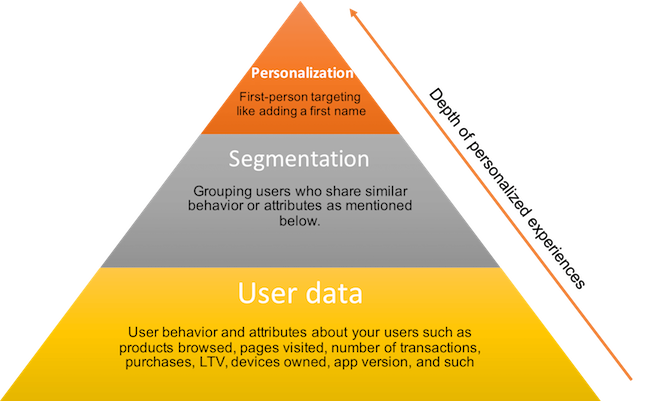Segmentation: The Pathway to Deeper Personalization

Reading Time: 5 minutes
According to a recent study by CMO.com, 74% of consumers get frustrated when brand messaging has nothing to do with their interests. Yes, we all wish brands could see eye-to-eye, with what’s going on in our lives. But for brands, the path to building meaningful messaging and engagement with customers is not an easy one. To achieve that, marketers will need a good understanding of the differences and relationships between customer data, customer segmentation, and personalization.
Segmentation and Personalization
Segmentation is looking at your user data and grouping users who exhibit similar behavior or share similar attributes. Take, for example, behavior such as ‘users who browsed for Android phones on your site/ app’, ‘users who shopped for a handbag’, ‘users who browsed Android phones and shopped a handbag’, things like that. The same extends to attributes like users owning a particular model of a smartphone, users residing in a given city, and such.
Personalization, on the other hand, is building a first-person perspective to interactions with your users focussed mostly on data about user behavior.

Look at the push notification on your left, for example. It is a case of customer segmentation, not necessarily personalization. The push campaign targets users who have played or listened to the artist Najim Arshad in the past.
Now, look at the push notification on your right – a simple example of a push notification with personalization. Calling out the user’s first name, Sameer gives your message a first-person perspective.

Segmentation, then personalization
Now that we understand the differences between segmentation and personalization let’s see how we can use them wisely to deliver personalized experiences to users.
Adding users’ first names in a notification or email, like in the example above, is the first step towards personalization. But that only shows that you don’t know anything about the user, other than his first name
What drives the point home (and purchase and revenue); is first creating relevant segments and personalize your messaging to users within the segment. Only then, you have something that says, “You know your users, you understand them, and that you care for them.”

As seen in the above diagram, the depth of personalized experiences depends on user data (acting as a base), creating segments out of it, and personalizing your messaging, giving it a first-person perspective.
Understanding the role of segmentation & personalization with an example
Let’s now look at a few examples of brands, which are getting the segmentation and personalization steps right for deeper personalized experiences.

1. Above, is an example of how a leading payment and mobile banking app, segments its users before sending a notification.
In this case, the app is encouraging prepaid mobile users to recharge their mobile currency via a push notification.
The segmentation is a blend of different categories of data like:
- User Behavior: Recharge_successful in the last 15 days users who have completed a recharge
- User Attributes: Prepaid user
- User properties: HSBC Bank
- Excluding custom segment: Prepaid users in the last 14 days
- Also notice the first-person personalization [First_Name], Peter, in the push notification as well.
The result is a higher degree of relevance and personal nature of the message to the users, increasing their tendency to act on the message.
2. Let’s look at another example. Here’s how SIVVI.COM, a leading e-commerce store segments the users and personalizes the notifications.

As seen, in the image on the left, using segmentation tags like [Product Browsed], SIVVI.COM can target users who browsed Nike sneakers and Adidas jerseys.
Personalization, on the other hand, is done using tags like [First Name], which inserts the user’s first name, i.e., George. Such personalized campaigns engage up to 15% of users – a significantly high number when compared to non-personalized or segmented campaigns.
3. Here’s an example where Gaana.com uses segmentation to deliver a personalized music listening experience to its 50 million + users.

As seen, Gaana uses MoEngage segmentation to target New users and personalization to address them by their First Name. The notifications nudge new app users towards a premium subscription. Gaana witnessed an uplift of 120% in premium subscriptions through MoEngage.
[Case Study] How Gaana app drives premium subscriptions and active users on the app, using MoEngage.

4. Here’s another example from SIVVI.COM, where they send emails showcasing items browsed but not purchased. The email is yet again, an excellent example of segmentation (users who browsed a category but didn’t buy) and personalization (items the users browsed like the Adidas shoes). These emails typically help recover up to 10% of abandoning users contributing to an increase in sales.
[Case Study] How SIVVI.COM increased sales using MoEngage dynamic emails and push notifications.
Conclusion
A layered approach for segmentation and personalization is the key to driving deep-level personalization for your brand. Skipping or altering the order of either of the steps, may not get your brand the expected results or outcome from marketing automation. To see how MoEngage can help your brand build deeper engagement with your customers, drop us a line below.







